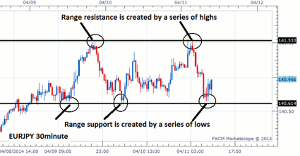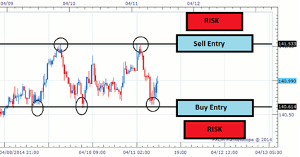Walker England of DailyFX.com lays out the basics for range trading to aid when the market losses its direction.
Many traders consider themselves trend traders. But what happens when the market loses its direction? Instead of being deterred by sideways price action, traders should develop a plan of action for ranging markets. Today, we will review how to identify a trading range, and an easy way to approach trading trendless markets.
Find the Range
The first task of range trading is to find the range! This process can be easily done by connecting a series of highs and lows with a horizontal trend line. The key is to find two points to connect on your graph. Once found, these values can be extrapolated to form a line of resistance and support, with the area in between defined as our trading range.
Below we can see an example of an active range on the EUR/JPY. Resistance has been formed by connecting two previous highs near 141.50. Likewise, support has been defined by connecting a series of lows near 140.60. The distance between these two points is a respective 90 pips which the range trader will look to take advantage of as long as support and resistance remain in place.
Learn Forex: EUR/JPY 30Min Trading Range
Planning an Entry
Once levels of support and resistance have been found, traders can begin planning to enter the market. One benefit of range trading is that traders can take a non-directional look at the market and place both buy and sell orders. Since price is moving sideways, orders to buy will be placed as close to our support line as possible. If price reaches resistance, the same stance can be taken but this time range traders will have a preference to sell the market.
Traders can set entry orders near support and resistance, or even trade with market orders. If you have limited time to trade, entry orders would be the preferred method of range trading. Entry orders will remain pending until price touches the designated level, prior to execution. Market order traders may use a system of confirmation before entering. Confirmation signals may include identifying a candle pattern or incorporating an oscillator signal prior to entering the market.
Learn Forex: EUR/JPY 30Min with Range Entries
Manage Risk
As with any trading plan, range traders need to consider risk. The major risks associated with trading ranges, comes from a potential breakout of support and resistance. In the event that support breaks, any buy positions should be vacated. As well, if resistance breaks, traders should consider the range invalidated and exit any sell orders. This process can be handled through the use of stop orders beneath levels of support or above key points of resistance.
By Walker England, Trading Instructor, DailyFX.com




















